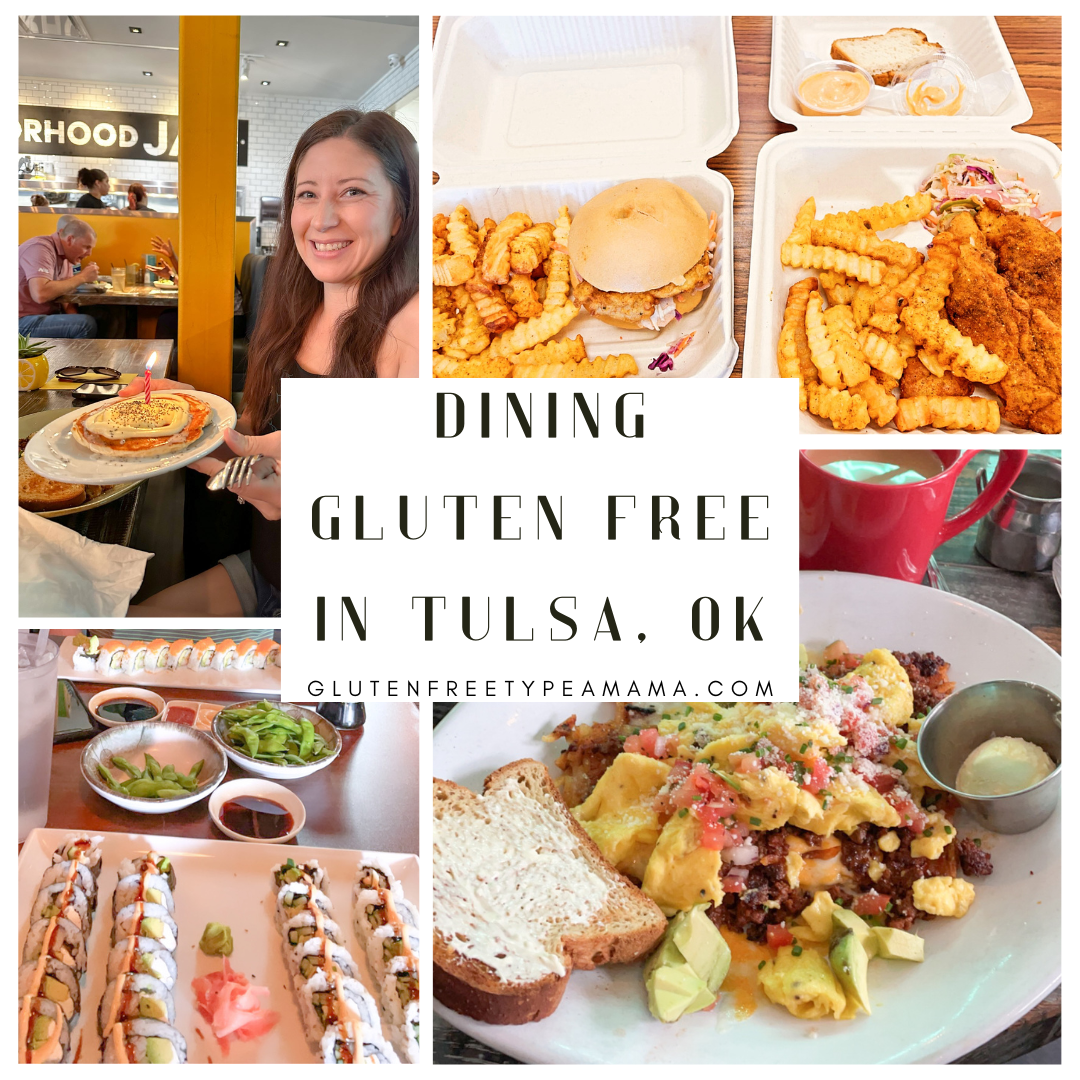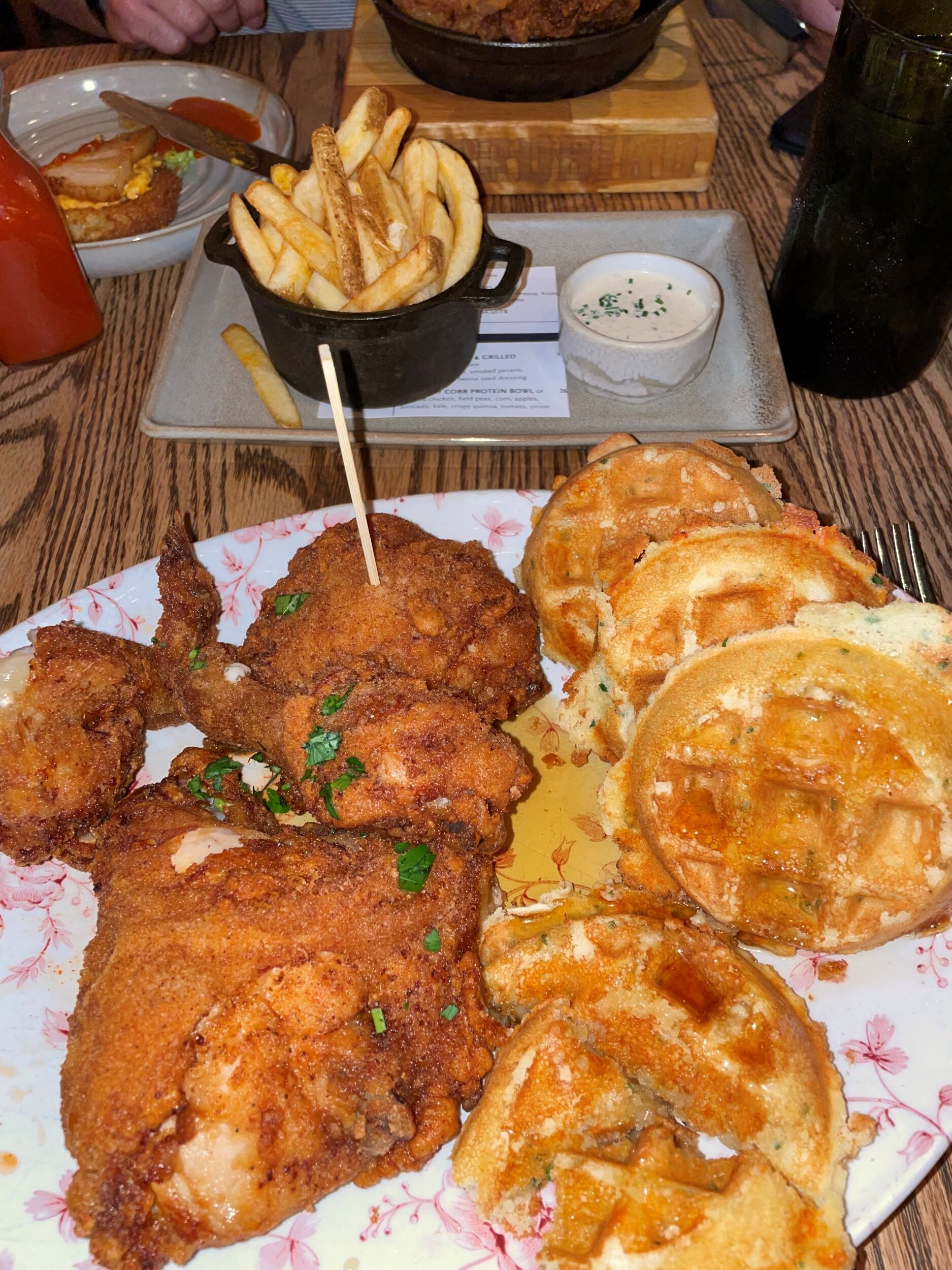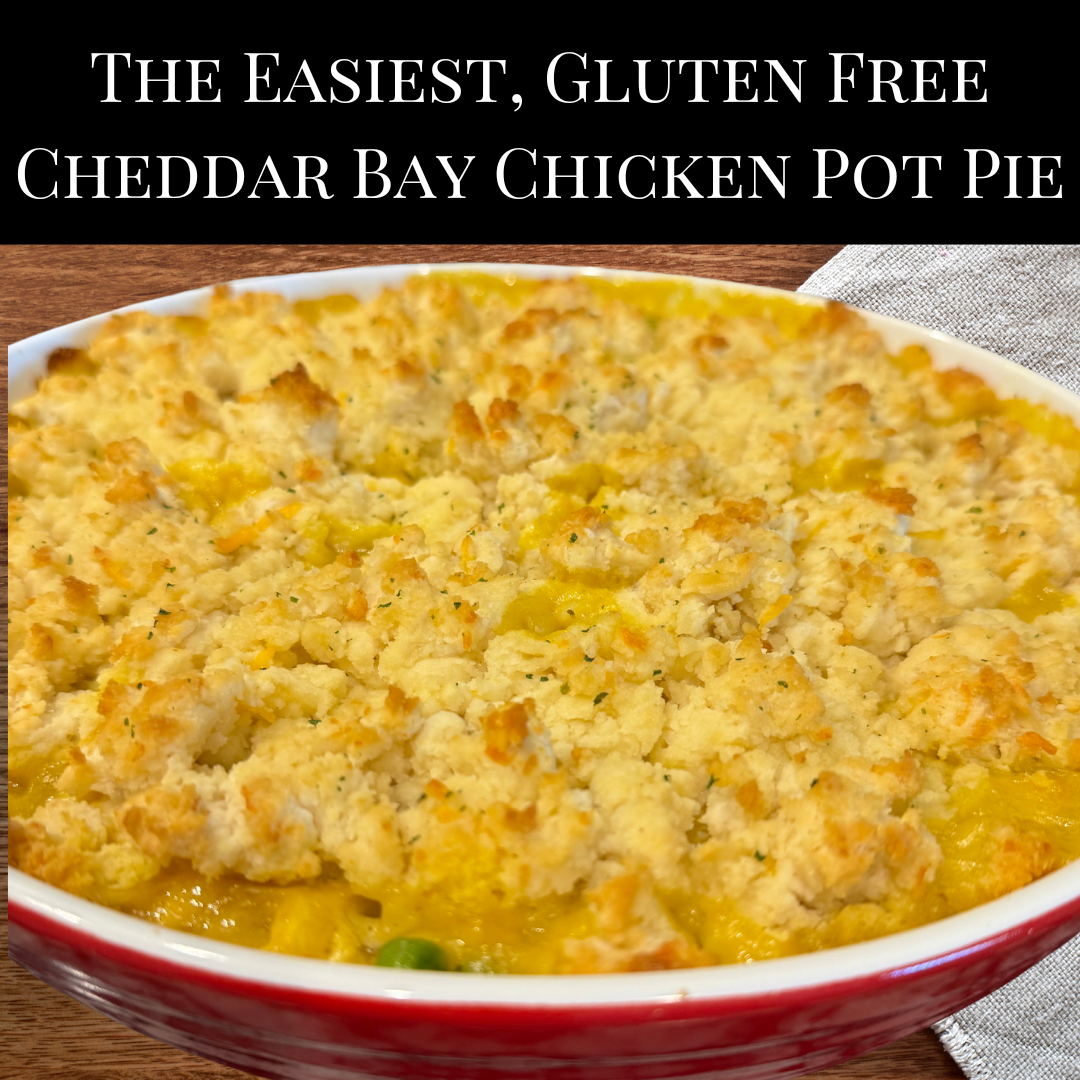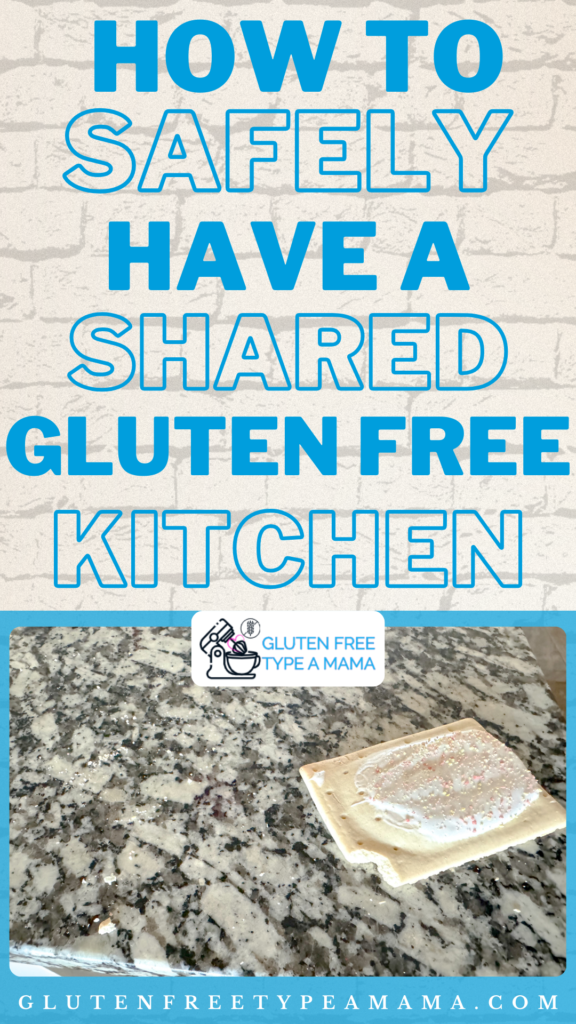
How to safely have a shared gluten and gluten free kitchen is an important topic when living with Celiac Disease. I live with my husband and two toddler sons that are all gluten eating. I don’t make them eat 100% gluten free because that isn’t cost effective for my family. I won’t enforce gluten free unless they are diagnosed Celiac. Now, when I say shared kitchen, I primarily mean packaged items. Our pantry has “gluten” labeled bins full of packaged items with gluten such as crackers, Goldfish, bread, cookies. Our family meals are always made gluten free because that is the easiest way to make meals. The only time we make separate meals with gluten is if it’s sandwiches. I don’t keep baking products with gluten in the house, such as flour, as I only bake gluten free.

You can access my How to Safely Follow a Gluten Free (GF) Diet Guide for helpful tips on how to safely eat gluten free, dining tips, label reading tips, and more.
Living in a Shared Gluten Free Kitchen with Kids
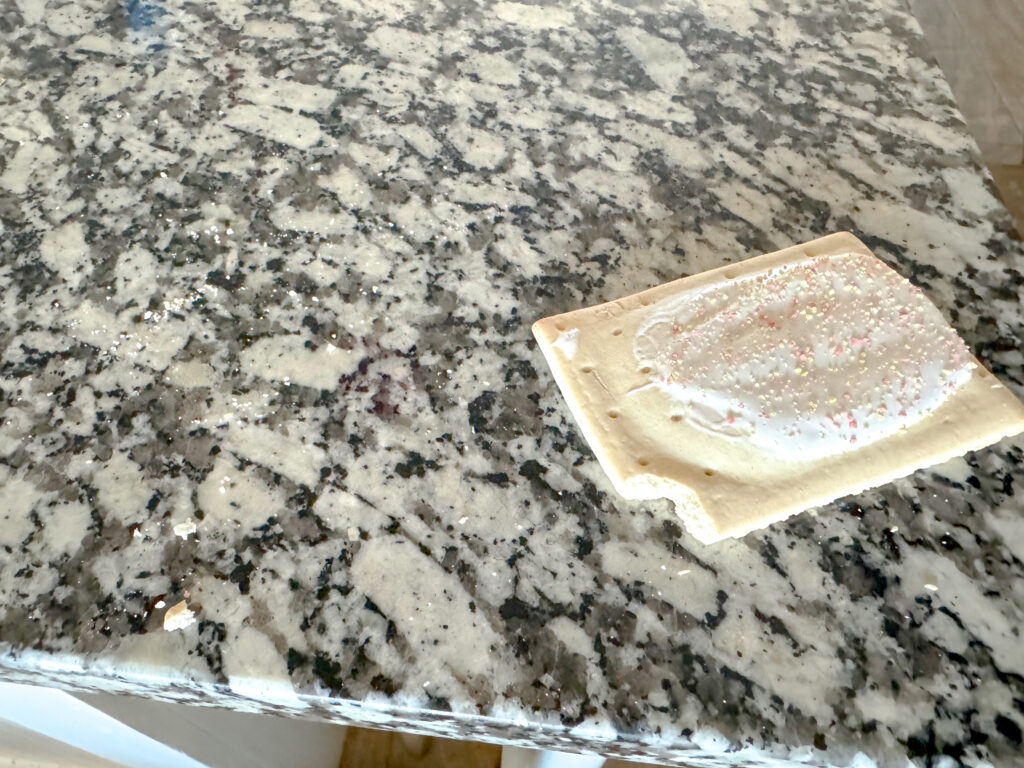
Life in a shared gluten free and gluten kitchen: I don’t know about you guys but walking past this gluten Poptart on my counter with crumbs all around it… gives me major anxiety! Even 5 plus years into eating gluten free, this gives me anxiety.
The only problem is things like the photo above. My kids are 4 and 2 years old and they don’t understand they can’t lay their food everywhere. We are working on doing better and they are learning. With that said, I made a list of tips that have helped me have a shared kitchen, so I hope it helps you, too. Download all the information in this post in PDF format here.
Check out my How to Safely Follow a Gluten Free (GF) Diet Guide, too! This guide has tips on reading labels, dining out safely, and eating at home.
8 Top Ways Your Gluten Free Food Can Be Contaminated with Gluten in a Gluten Free and Gluten Shared Kitchen
- using the same knife, fork, utensil, cutting board, strainer, or ladle that was used with gluten food and not washed after. This could be during cooking or during eating with a spouse -dipping their contaminated fork into your food.
- cooking on the same surface as gluten food such as pizza, grilled sandwiches, outdoor grill, griddle, microwave
- using the same appliance that is difficult to clean such as toaster, waffle iron, air fryer, (research shows strainers, wooden utensils, cutting boards are ok to share with washing between use)
- touching or laying GF food on high traffic surfaces in your kitchen that have had gluten containing foods on them (such as Poptart pic above)
- using a shared condiment that has touched gluten food or had utensil inserted with gluten (double dipping knife in mayo jar after touching bread)
- using shared microwave without covering food (gluten food spraying onto microwave and then later falling into your GF food)
- sharing sponges, cloths, or dish towels
- kid’s hands touching your plate or food after touching theirs
Items at High Risk for Gluten Cross Contact in a Gluten Free and Gluten Shared Kitchen
- condiments you dip into
- shared utensils
- shared dishwashing sponges/dishrags/hand towels
- toasters, waffle irons, air fryers, cast iron skillet, and other items not easily cleaned
- high touch surface areas in kitchen like counter tops, doors and handles to microwave, oven, fridge, etc.
- loose flour or baking products (I only use GF flours and baking items but if you choose to use gluten baking items you will need to take extra precautions since they can get messy real quick)
Solutions to High Risk Cross Contact Items
- Have separate condiments and label GF or use squeeze bottles
- When you’re newly starting a gluten free diet, all condiments will need to be marked “gluten” or thrown away and new condiments will need to be purchased to ensure safe eating for the people with Celiac in the home.
- Use different color sponges. 1 Color to wash gluten dishes, 1 color for gluten free dishes
- Different colored towels or use paper towels
- Separate kitchen equipment for gluten-free items – label them
- Clean high traffic surface areas regularly – counters, handles, etc
- Use containers with lids for gluten-containing flours
- Keep all gluten containing foods in one area of pantry/fridge

I label our gluten foods since there is less of it in the house. These items are all packaged so the bin sits right next to the gluten free foods.
Using colored labels may be more helpful for kids that are gluten free and can’t read yet.
Overall Tips for How to Safely Have a Shared Gluten and Gluten Free Kitchen
- use squeeze condiments such as this ketchup or mustard; or have your own labeled condiment bottles
- don’t put utensils back in condiment bottle after spreading it on gluten containing food such as mayo on a sandwich – don’t stick the knife back in to get more! You will need a new knife or wash it before getting more.
- label gluten free items with special color sticker/label or by writing gluten free: colors may be more helpful for children that can’t read yet and are the ones eating gluten free
- OR label gluten containing items instead if that’s easier. We label the gluten containing items because we have less of that in the house (e.g. Gluten peanut butter jar)
- do not share utensils – wash all utensils before switching between gluten and gluten free foods (e.g. husband taking bite of my food using his utensil with gluten on it)
- clean countertops with water and soap before and after each use or even after laying something down briefly (e.g. poptart)
- designate one area of the kitchen counter for gluten foods to be made or sat down on
- rinse all food particles off of dishes and then wash all dishes in dishwasher – this will thoroughly clean dishes to be safe for use
- if hand washing, wash all food off with water and soap and then use a clean sponge that hasn’t touched gluten to wash a second time
- have separate items -labeled GF- that can’t be thoroughly cleaned such as toaster, waffle iron, cast iron skillet, air fryer, bread maker, sandwich press, or use toaster bags for toaster
- store gluten free foods on separate plate/container away from gluten foods
- keep gluten containing foods at bottom of pantry and fridge to reduce cross contact – we currently don’t do this because it doesn’t work for us but if possible it’s a good idea
- you can choose to have separate items that are more susceptible to harbor gluten such as colanders, wooden spoons, or wooden cutting boards but research shows this isn’t necessary
DO’S
- make gluten free food first
- when we make sandwiches, I make mine first, then the rest of the family’s if they are eating gluten bread
- clean surfaces and utensils after each use
- label gluten free items and utensils/appliances in the home
- place all gluten items in one area of pantry/kitchen
- I have a gluten bin in our pantry, labeled
- rinse gluten dishes completely, then add to dishwasher to wash thoroughly
- or rinse and wash gluten dishes, then wash again with clean non-gluten contacted sponge
DON’TS
- use a utensil or dish after use with gluten food
- make food on same surface as gluten food
- assume counters, utensils/dishes left out are clean
- assume restaurants/waiters are knowledgeable about gluten free diets or celiac
- share condiments unless everyone in the house is educated on how to use them safely
Beyond Celiac also has a great handout on how to reduce cross contact in the home, with ideas on each room of the house.
Products in this Post
I am an amazon affiliate and do get a profit from items purchased from links on this post.

The Label Maker that I use : Brother P-Touch, PTM95, Handy Label Maker, 9 Type Styles, 8 Deco Mode Patterns

These removable labels are another option: MESS Food Labels for Containers – Removable Labels for Kitchens (96-Pack) Erasable Labels for Organizing

Download this Shared Kitchen Guide PDF here!
Disclaimer: This information is simply a guide to help you reduce cross contact at home. The information in this guide is not intended to be a substitute for professional medical advice, diagnosis, or treatment. All content found within this educational handout is for information purposes only. This handout is the property of Gluten Free Type A Mama. All rights reserved.



